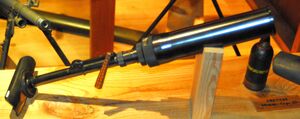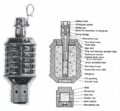Engineering:Type 10 grenade discharger
| Type 10 grenade discharger | |
|---|---|
 | |
| Type | Light mortar |
| Place of origin | Empire of Japan |
| Service history | |
| In service | 1921 - 1945 |
| Used by | Imperial Japanese Army |
| Wars | Second Sino-Japanese War, World War II, Indonesian National Revolution, Malayan Emergency, Korean War |
| Production history | |
| Designed | 1918-1920 |
| Produced | 1921-1945 |
| Specifications | |
| Mass | 2.6 kg (5 lb 12 oz) |
| Length | 525 mm (20.7 in) |
| Barrel length | 240 mm (9.5 in) |
| Shell weight | .53 kg (1 lb 3 oz)[1] |
| Calibre | 50 mm (1.97 in) |
| Effective firing range | (Type 91 grenade): 65 m (71 yd) |
| Maximum firing range | (Type 91 grenade): 175 m (191 yd) |
The Type 10 grenade discharger (十年式擲弾筒 Juu-nen-shiki tekidantō) was a Japanese smoothbore, muzzle loaded weapon used during the Second World War. It first entered service in 1921. The Type 10 has a range of 175 m (191 yd), greater than other grenade dischargers of that time. It had a range control device at the base of the barrel in the form of a graduated thimble by which a gas port at the base of the tube could be varied in size. For shorter ranges, part of the propellant gases escape to the side. Due to a translation error, the Type 10 was called the "knee mortar" by the Americans.[2] The manual for the mortar instructed the troops to carry the mortar on the upper thigh, with the base plate attached to the belt and the barrel running down the thigh. It was not strapped or secured directly to the thigh.[2] It was also carried strapped to the backpack. American troops on Guadalcanal became aware of the name "knee mortar" and thought the light design allowed it to be fired with the base plate resting on the thigh. If the Type 10 were fired in this manner, it would result in serious injury due to recoil.[2] However, once a few troops injured themselves, the mistranslation was discovered and further experimentation discouraged.
Contemporary US intelligence thought that the weapon was primarily used to discharge flares, the heavier Type 89 grenade discharger being used to fire explosive rounds instead.
Ammunition
- Type 91 grenade
- Type 11 smoke shell
- Type 10 flare shell
- Type 10 signal shell
- Type 91 pyrotechnic grenade
- Type 10 blank
See also
- Grenade launcher
- Two-inch mortar
Notes
- ↑ Chamberlain, Peter (1975). Mortars and rockets. Gander, Terry. New York: Arco Pub. Co. p. 12. ISBN 0668038179. OCLC 2067459. https://archive.org/details/mortarsrockets0000cham/page/12.
- ↑ 2.0 2.1 2.2 Rottman, Gordon L. (2005). Japanese Army in World War II - Conquest of the Pacific 1941-42. Oxford, England: Osprey Publishing. p. 46. ISBN 1841767891.
References
- Taki (Type 10) plala.or.jp
- "Chapter IX: Weapons". Handbook on Japanese Military Forces. Technical Manual. War Department. 1 October 1944. TM-E 30-480. http://www.ibiblio.org/hyperwar/Japan/IJA/HB/HB-9.html.
- Daugherty, Leo J. III (2002). Fighting Techniques of a Japanese Infantryman 1941-1945. Spellmount. ISBN 1-86227-162-3.
 |



